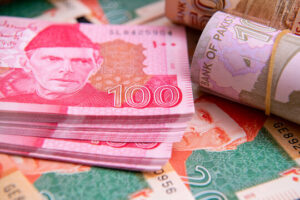
Reasons for Pakistan’s Currency Devaluation
Currency devaluation can occur for various reasons, and it’s often a complex interplay of economic, political, and global factors. The State Bank of Pakistan (SBP), the country’s central bank, has attributed the devaluation of the rupee to a number of factors, including the trade deficit, political instability, high inflation, rising global interest rates, and lack of foreign investment.

Balance of Payments Deficit: A significant reason for currency devaluation is a persistent trade deficit, where a country imports more goods and services than it exports. This results in a continuous outflow of its currency to pay for imports, putting pressure on the exchange rate. To correct the imbalance, the currency may be devalued to make exports cheaper and imports more expensive, thus encouraging domestic production and reducing the trade deficit.
Pakistan faced a balance of payments crisis, which contributed to the devaluation of the Pakistani Rupee. The country’s trade deficit had widened, leading to a drain on foreign exchange reserves. As per the Finance Division, the current trade deficit is $ 24.1 billion as against $ 39.1 billion last year.
Inflation: High and persistent inflation can erode the real value of a currency, making it less attractive to foreign investors and reducing its purchasing power. A central bank may devalue the currency to combat inflation by making imports more expensive. The inflation rate in August 2023 was 27.38%.
Political and Economic Instability: Political instability, corruption, and inconsistent economic policies can erode investor confidence and deter foreign direct investment (FDI). When investors perceive a lack of economic and political stability, they may pull their capital out of the country, causing the currency to devalue. Political instability and policy inconsistencies have been issues in Pakistan’s recent history, which can negatively impact investor confidence and the currency’s value.
Speculation and Market Sentiment: Forex markets are influenced by speculative trading and investor sentiment. Negative news or perceptions about a country’s economic prospects can lead to a sharp depreciation of its currency as traders sell off the currency due to fear or uncertainty. The British Pound experienced a sharp decline in value following the Brexit referendum in 2016. This was partly due to market sentiment and uncertainty about the UK’s future economic relations with the EU.
Rising global interest rates: The US Federal Reserve and other central banks around the world are raising interest rates in an effort to combat inflation. This is making it more expensive for Pakistan to borrow in foreign currencies, which is putting additional pressure on the rupee.
Lack of foreign investment: Pakistan has struggled to attract foreign investment in recent years. This is due to a number of factors, including the country’s political instability, high inflation, and trade deficit. The lack of foreign investment is depriving Pakistan of much-needed capital and further weakening the rupee.
Challenges of Currency Devaluation
The devaluation of the Pakistani rupee has a number of challenges for the country’s economy. It makes imports more expensive, which can lead to higher inflation and a reduction in living standards. It also makes it more difficult for Pakistani businesses to compete in the global market. Additionally, the devaluation of the rupee can lead to a loss of confidence in the economy and make it more difficult for the government to borrow money.
- Inflationary Pressure: A rapid currency devaluation can lead to imported inflation, as the cost of imported goods and raw materials increases. This can hurt consumers and businesses alike.
- Debt Burden: If a significant portion of Pakistan’s debt is denominated in foreign currencies, a devaluation can increase the cost of servicing that debt.
- Social and Political Unrest: The economic hardships resulting from a currency devaluation can lead to social and political unrest, posing challenges to governance and stability.
Opportunities of Currency Devaluation
However, the devaluation of the rupee also presents some opportunities for the Pakistani economy. It can make Pakistani exports more competitive in the global market and boost the country’s export earnings. It can also encourage domestic production and reduce the country’s reliance on imports. Additionally, the devaluation of the rupee can make Pakistan a more attractive destination for foreign investment.
- Export Competitiveness: A devalued currency can make a country’s exports cheaper for foreign buyers, potentially boosting exports and improving the trade balance.
- Tourism and Foreign Investment: A more affordable currency can attract tourists and foreign investors, as their purchasing power increases in the country.
- Structural Reforms: A currency crisis can be an impetus for policymakers to implement necessary structural reforms, such as fiscal consolidation, improving the business environment, and reducing corruption. Countries like Argentina and Turkey have undertaken structural reforms after experiencing currency crises to stabilize their economies.
The opportunities mentioned above are not active in the case of Pakistan because of our domestic ill policies. No increase in imports is yet observed because of the plight of domestic industries, and the cost of raw materials. No boom in tourism because of security challenges.
Currency devaluation in Pakistan, or any other country, is a complex issue influenced by a combination of economic, political, and global factors. While it poses significant challenges, it can also create opportunities for export growth and structural reform. To address the root causes of devaluation and capitalize on these opportunities, Pakistan would likely need to pursue prudent economic policies, attract foreign investment, and improve its overall economic stability.
Admin at The Pakistan Gazette

